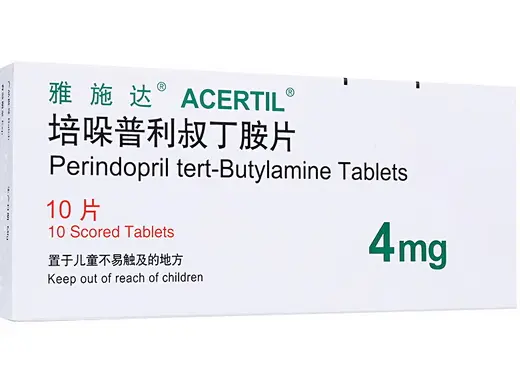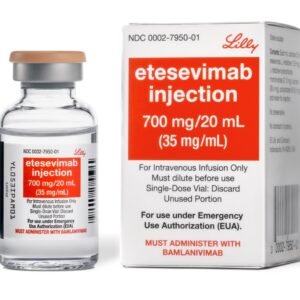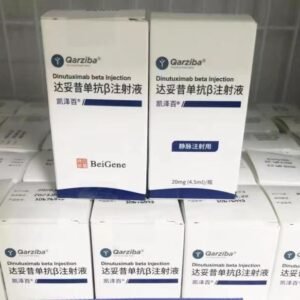Perindopril
Efficacy: Perindopril tablets are used to treat hypertension and congestive heart failure.
Dosage and administration:
It is recommended to take it once a day in the morning before meals. The dosage can be specific according to the patient’s specific situation and blood pressure response. Primary hypertension without sodium loss or renal failure (i.e. under normal circumstances): The effective dose is 4 mg/day, taken once in the morning. Depending on the efficacy, the dose can be gradually increased to a maximum dose of 8 mg/day within three to four weeks. If necessary, potassium-excreting diuretics can be used in combination to further lower blood pressure. Hypertensive patients who have been treated with diuretics: (1) Stop taking diuretics three days before starting treatment. If necessary, diuretics can be taken again later. (2) Or start treatment with 2 mg and adjust the dose according to the antihypertensive effect. It is recommended to monitor blood creatinine and blood potassium levels before treatment and within the first 15 days of treatment. Elderly: Start treatment with a low dose (2 mg/day, taken in the morning) and, if necessary, increase to 4 mg/day after one month. If previous examinations show that renal function abnormalities are not caused by age, the dose can be adjusted according to the patient’s renal function status if necessary. Creatinine clearance can accurately reflect the renal function of the elderly. Creatinine clearance is calculated based on serum creatinine and corrected by age, weight and gender using the Cockroft formula: clcr = (140-age) × weight (kg) / 0.814 × serum creatinine (mol/L). This formula is applicable to adult males, and females should be corrected by multiplying by 0.85. Renovascular hypertension: The recommended starting dose is 2 mg/day, and the dose is adjusted according to the patient’s blood pressure response. Serum creatinine and serum potassium should be checked to detect the presence of functional renal insufficiency. In case of renal insufficiency: The dose of perindopril should be adjusted according to the degree of renal insufficiency: (1) If the creatinine clearance is ≥ 60 ml/min, no dose adjustment is required. (2) If the creatinine clearance is < 60 ml/min, the recommended dose is: 30 < Clcr < 60 2 mg/day, 15 < Clcr < 30 2 mg/every other day. The usual medical treatment for such patients includes regular testing of serum potassium and serum creatinine, such as once every two months during the stable stage of treatment. In this case, the diuretic that can be used together is a loop diuretic. Hypertensive patients on hemodialysis (Clcr <15 ml/min): Perindopril can be removed by dialysis. The dialysis clearance rate is 70 ml/min. Give 2 mg of perindopril on the day of dialysis. Treatment of congestive heart failure starts with a low dose, especially in cases with low or normal initial blood pressure, renal failure, and hyponatremia (whether drug-induced or not). ACE inhibitors can be used in combination with diuretics, and digitalis glycosides can be added if necessary. It is recommended to start treatment with 2 mg every morning while monitoring blood pressure. If necessary, increase to the conventional therapeutic dose, that is, 2-4 mg per day, taken once. The daily therapeutic dose should be selected so that the standing systolic blood pressure is not less than 90 mmHg. Patients with high-risk heart failure (severe heart failure, patients receiving high-dose diuretic treatment) may experience symptomatic hypotension after taking the drug. The starting dose for such patients should be halved (i.e.: 1 mg/day). Serum potassium and creatinine should be tested each time the dose is increased, and according to the cardiac function classification, the test should be performed every 3-6 months to evaluate the safety of treatment.
Adverse reactions:
Clinical side effects Headache, fatigue, dizziness, mood or sleep disorders, painful cramps. Postural or non-postural hypotension. In a few cases, rash, stomach pain, anorexia, nausea, abdominal pain, taste disorders. Dry cough has been reported to be associated with the use of ACE inhibitors, which is characterized by persistence, but the dry cough disappears after discontinuation of the drug. If the above situation occurs, it should be considered that this symptom may be caused by the drug. Angioneurotic edema is rare. Effects on laboratory indicators Moderate increase in blood urea and serum creatinine, which can be restored after stopping treatment. This increase is more common in patients with hypertension and renal failure with combined renal artery stenosis and diuretic treatment. In patients with glomerular nephropathy, ACE inhibitors can cause proteinuria. Hyperkalemia, usually transient. Anemia has been reported in special patients (renal transplantation, hemodialysis) treated with ACE inhibitors.
Contraindications:
Contraindicated if allergic to this product. Contraindicated during pregnancy. Contraindicated during lactation. Use with caution in children. Use with caution during lactation. Use with caution when driving. Use with caution during pregnancy.
Share:
Products
Our offers
Health Classification
Let us work together to protect precious health



























